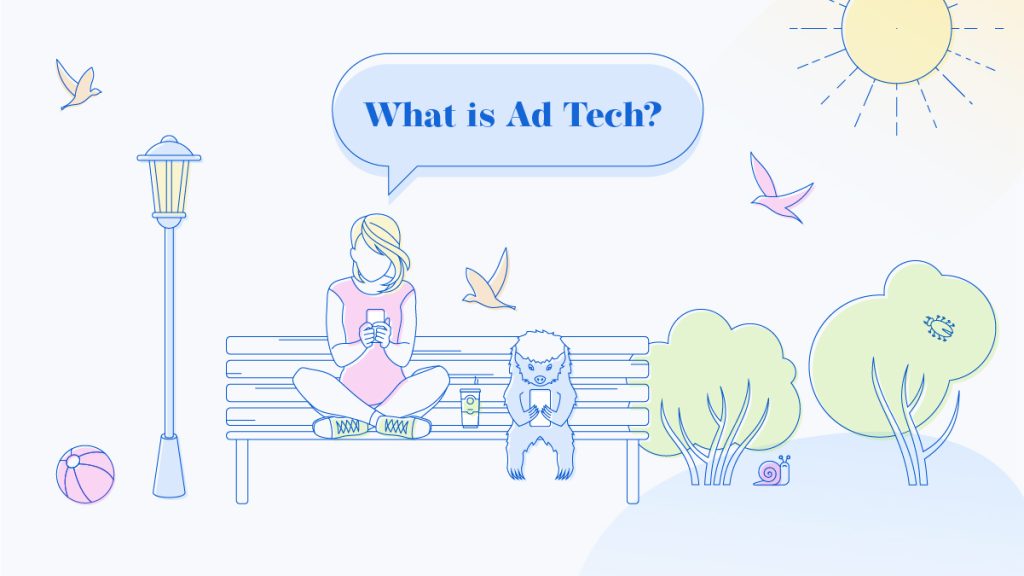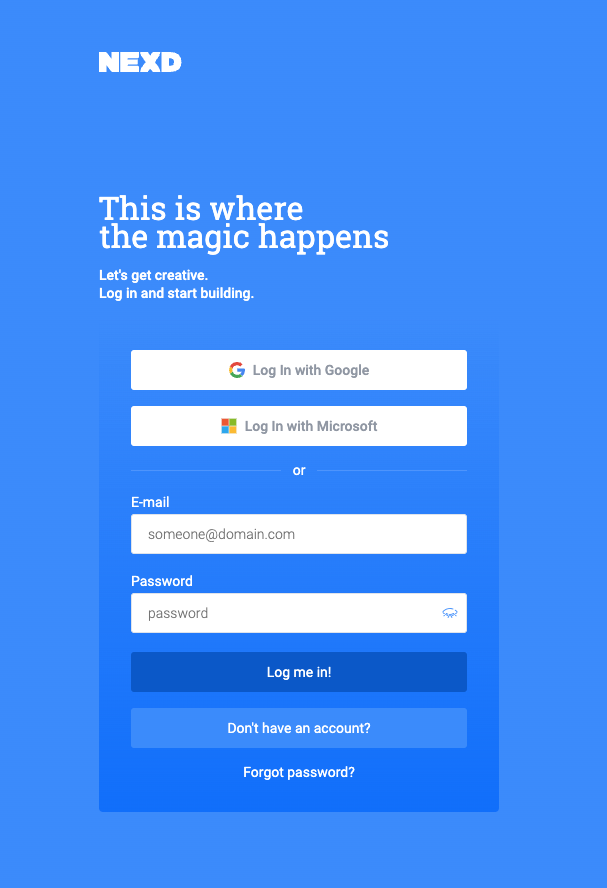What is Advertising Technology (AdTech) – A Guide and Explanations
The following content will explore Ad Tech’s key concepts and terms: ad exchanges, demand-side, and supply-side platforms, and will explain the difference from Mar Tech. In addition, you’ll learn key advertising technology terms and trends to watch in this industry.
So whether you are a marketing professional, publisher, or advertiser, this ultimate guide is enough for you to learn the nitty gritty of Ad tech.
To help you navigate across all topics in this article, please refer to the Table of Contents below:
- Introduction
- Advertising Technology
- What exactly is advertising technology?
- What is the difference between Ad Tech and Mar Tech?
- Focus
- Channels
- Goals
- Tools
- Billing
- Users
- Examples of Mar Tech
- Examples of Ad Tech
- What are Ad Tech benefits?
- Better Use of Advertising Budget
- Cross-Platform Advertising
- Data Insights
- Enhanced Campaign Monitoring
- Advertising Innovation
- Basics of AdTech
- What is Programmatic advertising?
- Demand-Side Platforms (DSPs)
- Supply-Side Platforms (SSPs)
- Ad Networks and Ad Exchanges
- Ad Servers
- Data Management Platforms (DMPs)
- Key advertising technology terms
- Impressions
- Click-Through Rate (CTR)
- Cost Per Click (CPC)
- Cost Per Impression (CPM)
- Viewability
- Retargeting
- Engagement/Attention metrics
- The five best ad tech tools
- Nexd
- MediaSmart
- BigAds
- Quantcast
- Equativ
- Conclusion
What exactly is advertising technology (AdTech)?

In a broad sense, advertising technology refers to the programs, platforms, networks, and other tools publishers, advertisers, and other entities use to purchase, sell, and handle digital advertising. Ad Tech focuses primarily on paid channels.
Most areas where you see advertisements fall under this category, including social media, google, email, and others. They help you manage your online advertising campaigns easily. For example, ad Tech tools help you launch ads, others let you analyze them, and others automate day-to-day tasks.
Now, the world of programmatic advertising operates on a two-sided model. Publishers, who represent the supply side, aim to build a thriving audience for their platforms, whether it’s a site, an app, or another digital asset. On the other hand, the demand side, which the advertisers represent, wants to reach that audience with advertising that is relevant to them and effective at generating conversions.
A critical factor in getting these two parties together is ad tech. Advertisers use cutting-edge technologies and tools to target their ideal demographic, improve their campaigns, and calculate their return on investment. Publishers, meanwhile, use audience data to deliver tailored ad placements, increase ad revenue, and learn essential things about how visitors behave.
Programmatic advertising, real-time bidding, ad exchange, and demand-side platforms are just a few of the tools and programs the ad tech sector offers to help publishers and advertisers accomplish their objectives. With these tools, both parties can collaborate on creating a mutually healthy ecology that benefits everyone.
As a side note, you may have previously heard the term “marketing technology (Martech)” and may be unsure of its distinction. Although a subset of MarTech, AdTech focuses more on paid advertising.
Let’s understand their distinction in detail.
What is the difference between Ad Tech and Mar Tech?
Marketing technology (MarTech) and advertising technology (AdTech) are the two categories of digital marketing. The two have several significant distinctions, even though they have some parallels and overlap in certain areas.
What is MarTech?
The technologies and tools marketers use to enhance their marketing efforts are known as “MarTech.” It covers various topics, such as email marketing, managing social media, analytics, customer relationship management (CRM), content management systems (CMS), and more.
What is Ad Tech?
According to Gartner, “Ad tech is a set of technologies used for managing advertisements across channels, including search, display, video, mobile and social, with functions for targeting, design, bid management, analytics, optimization and automation of digital advertising.”

Globally, 26.6% of marketing budgets focus on MarTech.
Source – Gitnux

Get Started
Sign up to Nexd Campaign Manager for a free 14-day trial and start creating environment-friendly and highly engaging programmatic creatives!
Let’s dive into the key differences between AdTech and MarTech:
- Focus:
MarTech concentrates on implementing marketing initiatives and the entire marketing strategy. Whereas AdTech focuses on delivering, managing, and optimizing advertising campaigns.
- Channels:
Various marketing channels, including email, social media, google search, content, and more, all employ MarTech solutions. Programmatic advertising channels like displays, multimedia, mobile, digital-out-of. home and audio advertising are part of AdTech tools.
- Goals:
MarTech’s primary objective is to develop and nurture customer relationships by distributing tailored, helpful, and engaging content across various channels. In addition, AdTech delivers ads to the targeted people at the right time and location to maximize the return on investment (ROI) for advertising spend.
- Tools:
MarTech products include platforms for marketing automation, advanced analytics, and more. Programmatic advertising, real-time bidding, ad exchanges, demand-side platforms (DSPs), and supply-side platforms (SSPs) are examples of Ad Tech tools.
- Billing:
MarTech and AdTech employ several payment models. AdTech tools are often invoiced on a cost-per-impression (CPM), cost-per-click (CPC), or cost-per-action (CPA) basis. MarTech tools are frequently licensed on a subscription-based model or offered as a one-time investment.
- Users:
Marketing professionals, marketing departments, and business owners in marketing campaigns generally utilize MarTech tools. Likewise, marketers, media buyers, and agencies employ Ad Tech technologies to manage and purchase ad campaigns.
Now that you know the difference between AdTech and MarTech, let’s look at some examples for better clarity.
Examples of AdTech:
PS: Many examples of AdTech and Martech tools and types are available in the market, and we’d like to highlight just a few.
- Programmatic advertising:
It comprises tools that let advertisers target particular demographics, establish bids, and oversee their ad campaigns, such as Google Ads and Amazon advertising. Read more about ad tech giant Google changing their ad serving fees!
- Demand-side platforms (DSPs):
These enable media buyers to handle programmatic ad buying in one location and access different ad exchanges. Check out our 17 best ad tech platforms (DSPs) list!
- Supply-side platforms (SSPs):
These enable publishers to maximize their income by establishing floor prices and fill rates while selling their ad inventory via ad exchanges.
- Creative management platforms (CMPs):
A CMP is an end-to-end platform that enables businesses to design, scale, and optimize their digital advertising content efficiently. Read our comparison of best CMPs here.
Examples of MarTech:
- Marketing automation platforms:

Marketers can automate email campaigns, lead nurturing, and other marketing processes with HubSpot, Marketo, and Pardot.
Source: Extern Labs
- Customer relationship management (CRM) systems:
Some tools included in the suite are Salesforce, Zoho, and Microsoft Dynamics. These tools can help businesses handle customer data, track interactions, and enhance customer service.
- Content management systems (CMS):
It includes WordPress, Drupal, and Joomla, which allow marketers to manage, create, and publish
- Search Engine Marketing (SEM):
There are platforms for search engine marketing where you can buy ads to boost the visibility of websites in search results. Google Ads is the most well-known of these.
content.
- Analytics tools:
Various tools exist to help marketers measure the success of their marketing campaigns, such as Google Analytics, Adobe Analytics, and Mixpanel. Their marketing strategy is optimized based on tracking user behaviour.
What are AdTech Benefits?
- Better Use of Advertising Budget:
AdTech can assist companies in better allocating their advertising budgets for maximum impact. The cost of reaching uninterested users is lower with targeted advertising. It is because it shows ads only to those who are likely interested in the product or service.
AdTech can also optimise ad placement bids, assuring advertisers receive the most bang for their buck.
- Cross-Platform Advertising:
AdTech allows advertisers to connect with users on various channels and gadgets, including linked TV, mobile, and desktop. It enables marketers to reach consumers on any device and from any location. The ability to track users across multiple devices is also a benefit of cross-platform advertising, as it can provide additional data and insights.
Advertising technology also includes mobile ad servers, read more here!
- Data Insights:
AdTech gives marketers insightful data that they can utilize to enhance their advertising campaigns. Campaigns can be optimized and targeted more precisely using audience behaviour, ad performance, and user engagement data. AdTech can also inform users about preferences and behaviour to improve products and the entire business strategy.
- Enhanced Campaign Monitoring:
AdTech gives advertisers access to real-time analytics on ad performance, enabling them to manage programs more efficiently. You can find data impressions, views, interaction, and conversion rates with this data. Advertisers can utilize this information to determine which campaigns are succeeding and which are failing, allowing them to make real-time adjustments for enhanced performance.
Advertising Innovation
Innovation in advertising refers to creating and deploying new strategies and tactics to produce goods, services, viewpoints, or causes known to the public to influence the general public to act in a particular manner toward the marketed product. Meanwhile, innovative marketing promotes new goods and services as they develop. According to Gartner, more than 20% of marketing expenditures are allocated to innovation in marketing, although many marketers struggle to define innovation.
Innovation in the corporate world refers to the capacity to conceive, create, supply, and scale new consumer goods, services, procedures, and marketing strategies.
Advertising must use cutting-edge methods to be current and effective in a constantly evolving market. Examples include rebranding, packaging, or introducing fresh ways to introduce a product. In addition, advertising technology drives innovation in areas like greater personalization, smooth automation, improved metrics, and more.
Basics of Ad Tech
The research, administration, and distribution of advertisements, depending on ad needs, is the primary responsibility of ad tech. Ad Tech encompasses a range of tools, including demand-side platforms, supply-side platforms, ad servers, data management platforms, and ad networks.
Let’s go through each one of them in detail.
What is Programmatic advertising?

Programmatic advertising deploys software to automatically purchase, distribute, and optimize ad inventory across numerous websites and platforms in real-time. It utilizes information and algorithms to send tailored adverts to particular audiences at the appropriate time and location. For marketers to access their target audience at scale, a sophisticated network of ad tech platforms, data suppliers, and ad exchanges is required.

Get Started
Sign up to Nexd Campaign Manager for a free 14-day trial and start creating environment-friendly and highly engaging programmatic creatives!
Technicalities of Programmatic Advertising
Let’s use an example to understand how programmatic advertising operates. Consider that you are managing a digital marketing campaign for a brand-new collection of running shoes. You’ve determined that your target market consists of ardent joggers between 18 and 35, and you want to advertise to them so they’ll buy your new shoes.
For that, you’ll have to establish a demand-side platform (DSP) campaign to get started with programmatic advertising. Then, you can interact with numerous ad exchanges and publishers with open ad space. Finally, you may choose the optimal stock based on data and target criteria. Find here the 17 best DSPs we recommend!
After establishing your campaign, you may choose the optimal inventory for your advertising by using information and targeting criteria. For example, it could involve particular sites, social media networks, or persons within your target demographic.
Users’ online activity is monitored and evaluated in real-time as they interact with digital information across the web. Programmatic advertising algorithms that determine automated purchasing choices depending on the probability that a specific user will be interested in your advertisement get informed by this data. For instance, a person might be more inclined to notice your advertisements for your new line of running shoes if they have just searched for running shoes online.
Programmatic advertising assures that your ads display to individuals most interested in your goods or services instead of buying ad space on many sites and expecting your intended audience to find them. Decreasing lost ad spend on pointless impressions not only improves the performance of your advertising efforts but may also result in long-term financial savings.
Demand-Side Platforms (DSPs)
A real-time software suite known as a DSP enables marketers and agencies to buy advertising inventory. It connects to several supply-side platforms (SSPs) and advertising exchanges to acquire a range of stocks.
Once linked, advertisers may bet on ad impressions using targeting criteria, including demographic information, geography, and surfing habits. Then, via an automated bidding procedure, these bids occur in real-time, and the highest bid receives the impressions and has their ad displayed to the user.
Advertisers may effectively and successfully handle their ad campaigns by utilizing a DSP. Companies can alter their targeting settings to address the appropriate demographic, real-time optimize their bids depending on performance analytics and even define campaign budgets and objectives.
The Trade Desk, MediaMath, and Google’s DV360 are well-known DSPs. These platforms have changed how advertisers view programmatic advertising, making it easier to reach targeted consumers at scale than ever before.
Supply-Side Platforms (SSPs)
In the programmatic advertising ecosystem, supply-side platforms (SSPs) are another essential player. Publishers use SSPs as management and sales tools for their ad inventory.
Here’s the process- In response to a user visiting a website with ad space, the SSP receives data about the user and the website. The SSP uses this information in an auctioning process called Real-time Bidding. As a result, publishers can maximize revenue by selling their ad space in real-time to the highest bidder.
Additionally, publishers can set minimum prices for ad space and monitor ad performance using their tools.
Google Ad Manager is one example of an SSP. It enables publishers to control and market their ad stock across numerous platforms, such as sites, applications, and videos. Rubicon Project and Pubmatic are other well-known SSPs that provide several services, including audience targeting and monitoring.
Ad Networks and Ad Exchanges
Ad networks collect inventory from different publishers and make it available for advertisers. As a result, they serve as a middleman between publishers and advertisers, opening the door to a variety of stock that wouldn’t be accessible through direct publisher partnerships. In addition, ad networks often utilize their technologies to administer and improve ad campaigns.
An ad exchange is a digital marketplace where publishers can sell real-time inventory with advertisers. By enabling advertisers to place real-time bids on views, ad exchanges streamline the purchase and sale of advertising inventory. In addition, they offer publishers a chance to provide their stock to the highest bidder to increase their revenue and an open and reliable mechanism for advertisers to buy advertising inventory.
The programmatic advertising system includes both advertising networks and ad exchanges, which expose advertisers to a sizable amount of inventory while enabling publications to monetize their content. Google AdSense and Conversant are two instances of well-known ad networks, whereas OpenX and DoubleClick Ad Exchange are two instances of ad exchanges.
So, the next time you casually surf the net and come across an ad, remember that it is likely because of a sophisticated system. The demand-side platforms, supply-side platforms, ad networks, and ad exchanges all work in a loop to provide you with the right ad to the right person at the right time.
Ad Servers
A technology platform, an ad server, distributes targeted audiences with digital adverts. It’s essential for online advertising to deliver advertisements to the intended audience at appropriate times effectively.
Consider ad servers as the delivery people of the advertising business to understand how they operate. When an advertiser makes an advertisement, they publish it to an ad server with detailed information about who and when they would like it to run. The ad server ultimately retains this data when a user visits a site or employs an app part of the ad network or exchange.
Moreover, ad servers monitor and analyze ad performance to assist advertisers and publishers in improving their campaigns. For example, companies can monitor statistics such as clicks, engagements, and conversions and utilize the information to boost targeting and modify bidding tactics. Google Ad Manager, AdButler, and OpenX are examples of ad server providers.
Nexd Ad Serving
At Nexd, we appreciate the significance of effective and precise ad serving. Because of this, all creatives exported from our Campaign Manager contain ad serving, saving advertisers both money and time. Additionally, with Nexd, you don’t have to be concerned about paying an additional charge since it’s already incorporated into the ad-serving creative on your DSP.
With the help of our ad-serving technologies, we can deliver advertising swiftly and effectively without sacrificing its quality. We apply extensive compression methods to make ad files smaller and load more quickly for users. Furthermore, our technology allows advertisers to customize their advertising to suit diverse platforms, audiences, and devices.
Data Management Platforms (DMPs)
Advertisers must understand their target audiences and behaviours to create more effective campaigns. Data management platforms (DMPs) play a role in this. DMPs are media that gather, store, and analyze user data from various channels, including sites, mobile applications, and social networks.
Imagining the DMP as a library with different books representing different data types, such as demographics, interests, and browsing history, would help clarify what it is. The DMP compiles all these books and organizes them into categories so advertisers can access the required data more quickly.
Depending on user behaviour and preferences, advertisers can design highly customized and targeted ads using a DMP. For example, if you are searching for skincare products often. DMPs will help advertisers target users frequently visiting skincare websites with skincare-focused ads.
Adobe Audience Manager, Oracle BlueKai, and Lotame are well-known DMPs. These platforms provide a wide range of functions to assist advertisers in making the best use of their data, such as target market segmentation, data activation, and data visualization.
I hope you understand what Programmatic advertising is and its several components. First, however, we’d like to explain specific terminologies used in advertising. These terms will help you comprehend the performance and usefulness of your ad campaign.
Key advertising technology terms
- Impressions:
It refers to the number of times your advertisement appears on a website or app. They determine the campaign’s reach and the frequency at which users see your advertisement.
- Click-Through Rate (CTR):
Click-through rate means the percentage of users who click on your advertisement after seeing it. CTR measures how well your advertising draws consumers’ attention and motivates them to act quickly.
- Cost Per Click (CPC)
The sum of money you pay each time one of your ads is clicked by a user. An advertiser’s cost per click determines how much they will pay per interaction.
- Cost Per Impression (CPM)
The CPM is the value of 1,000 displays of your advertisement. CPM determines how much you will spend for each impression and the cost of executing your campaign.
- Viewability
The percentage of your advertisement that users can see when it’s displayed. Viewability is a crucial indicator for gauging your advertisements’ success. It also helps in ensuring that users are seeing them.
- Retargeting
It displays ads to those individuals who’ve previously engaged with your brand or browsed your website. It is an effective strategy for raising conversion rates and boosting sales.
- Engagement/Attention metrics
These metrics determine how users interact with your advertisements, such as the time spent on the page, the completion rate of videos, or the scroll depth. In addition to helping you understand whether or not users are likely to take action, these metrics can also help you understand how engaged they are with your content.
The Five Best Advertising Technology Tools
If you’re curious about what technology is used in advertising, keep reading to learn about the different ad tech solutions currently available to advertisers.
Nexd provides an end-to-end solution for developing, producing, and presenting high-performing ads within media and devices. It is a creative management platform with tools like drag-and-drop design, asset management, and advanced analytics. Our platform also provides interactive ad forms such as playable commercials, 3D ads, and immersive virtual reality ads.
If any of these interests you, we recommend you take a product tour today.
PS: You’ll move to the new era of digital advertising 😉😉😉
Marketing professionals may unify the customer journeys across linked devices, including mobile, CTV, and DOOH, due to the omnichannel programmatic platform mediasmart. It assists in improving brand message targeting and personalization to offer a cohesive and compelling message by utilizing online and offline behavioural signals.
BigAds is an advertising technology platform that creates rich media creative tags for premier publisher websites. This platform allows marketers to design and use attention-based optimization to optimize their chosen media and creatives.
Quantcast is a tool for measuring audience size that provides data analytics to help you properly analyze the online and mobile traffic that visits your site. By using the Quantcast Platform to manage audience and inventories more efficiently, you can observe the real-time effects on your evaluation and conversion performance KPIs. It will help you increase awareness and consideration.
Equativ is a platform that enables you to interact with your target markets through their online marketplace. They can enhance your campaign KPIs and increase sales. They provide a single entry point to their cookieless-ready SSP marketplace. You can conduct business with Equativ via PMPs, PGs, Direct Deals, and open auctions.
Conclusion
Any successful advertising campaign depends heavily on advertising technology. Advertising professionals can create and deliver advertising to their intended audience that is more beneficial by knowing the tools and technology available. Nexd is one such tool that provides cutting-edge technology to streamline the advertising procedure and enhance campaign performance.

Get Started
Sign up to Nexd Campaign Manager for a free 14-day trial and start creating environment-friendly and highly engaging programmatic creatives!
